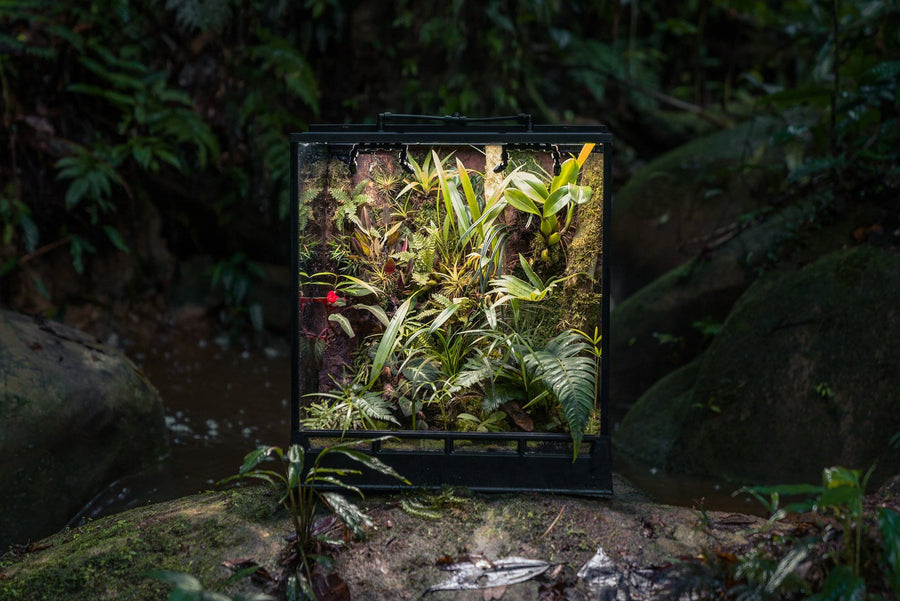Rhaphidophora
Rhaphidophora is a popular tropical plant genus that’s become a standout in the indoor plant scene. Known for its bold foliage and natural climbing habit, it's a favorite among plant lovers who want to bring vertical interest and dense greenery into their space. Its architectural leaves (often narrow, split, or fenestrated) give it a sculptural look that adds instant jungle vibes to any room..
In its natural habitat, stretching across Southeast Asia, New Guinea, and parts of Australia, Rhaphidophora grows in warm, humid rainforests. It thrives in low-light undergrowth, using its aerial roots to climb trees and structures in search of sunlight. Some species can grow remarkably large in the wild, sprawling across the forest floor before reaching upward.
In this guide, our plant care experts will share their tips for successfully growing Rhaphidophora indoors.
💡Though it's frequently mistaken for Monstera due to similar leaf patterns, Rhaphidophora isn’t related and has its own care requirements.

What lighting do Rhaphidophora prefer?
Rhaphidophora love bright, indirect light. Filtered sunlight or a spot a few feet away from a window is perfect. Direct sunlight, especially harsh afternoon sun, can scorch the leaves. If your plant’s growth seems sluggish or the leaves are smaller than expected, it might not be getting enough light. On the flip side, leggy growth can also mean it's stretching toward a light source as it is not getting enough light in the spot it is currently in.
What humidity is best for Rhaphidophora?
These plants prefer moderate to high humidity levels, ideally around 50–60%. While they can tolerate average household humidity, anything too low can lead to browning leaf tips. If you notice crispy edges, especially in winter, consider using a humidifier or placing your plant on a pebble tray with water to boost moisture in the air.
What temperature does Rhaphidophora need?
Rhaphidophora is hardy within a temperature range of 18–30°. It's a tropical plant at heart, so it doesn’t like cold drafts, sudden temperature drops, or being too close to air conditioners or heaters. Keep it away from doors and windows that get chilly at night.
How often should I water my Rhaphidophora?
Rhaphidophora is prone to root rot, so overwatering is the biggest risk. Always check the soil before watering. Wait until the top inch feels completely dry and don’t just go by the calendar. In warmer months, you may water more often, while winter usually requires less.
During the growing season (spring and summer), mix in a balanced liquid fertiliser every 2-4 weeks to keep your plant growing strong and lush.
What soil is best for Rhaphidophora when repotting?
This plant needs a chunky, well-draining soil mix to prevent water from pooling around the roots. A mix that combines organic matter (like coco coir or peat) with aeration components (like perlite or bark) works best. If you’d like to take the guesswork out of the equation, check out our pre-blended Potting Mixes, especially designed for houseplants.

Common Issues for Rhaphidophora
Even though Rhaphidophora is a relatively low-maintenance and hardy houseplant, it’s not immune to problems. Here’s what to watch for and how to respond:
Wilting Leaves
Wilting is usually the plant’s first red flag and can be caused by two very different issues: underwatering or root-related stress. If the soil is bone dry and the leaves look limp, the plant is likely dehydrated. However, if the soil feels wet and the leaves are still wilting, the issue may be below the surface—compacted roots, poor drainage, or the early stages of root rot can all cause similar symptoms. Always check the soil moisture and root health before reacting.
Yellowing Leaves
Yellow leaves can have multiple causes. If older, lower leaves are yellowing and dropping occasionally, that’s normal—it’s just the plant shedding old growth. But if multiple leaves are turning yellow at once, it could be a sign of overwatering or poor drainage. On the flip side, nutrient deficiencies—especially nitrogen—can also lead to fading, pale leaves. If your watering routine is on point, try adding a balanced fertilizer during the growing season.
Pest Infestations
While not the most pest-prone plant, Rhaphidophora can attract common houseplant pests like spider mites, mealybugs, and thrips—especially in dry, dusty environments. You might notice sticky residue, webbing, or small specks on the leaves. Routine inspections and regular leaf cleaning go a long way in prevention. If you do spot pests, isolate the plant and treat it promptly with insecticidal soap, neem oil, or another appropriate treatment.
Root Rot
Root rot is one of the most common and serious issues for Rhaphidophora. It occurs when the roots sit in soggy soil for too long, depriving them of oxygen and inviting fungal infections. Symptoms include blackened, mushy roots, yellowing or wilting foliage, and a sour smell coming from the soil. Prevent root rot by using a well-draining soil mix, ensuring your pot has drainage holes, and allowing the top inch of soil to dry out between waterings.
Other Signs to Watch
-
Brown leaf tips or edges: Usually a sign of low humidity or inconsistent watering.
-
Leggy growth: Often caused by insufficient light—move your plant closer to a bright, indirect light source.
-
Slow growth: This could mean the plant is in dormancy (especially during cooler months) or needs a nutrient boost during the growing season.
💡 Keep the leaves clean. Dust acts as a barrier that reduces light absorption and can attract pests. A quick wipe with a damp cloth every few weeks can make a big difference in your plant’s health.






